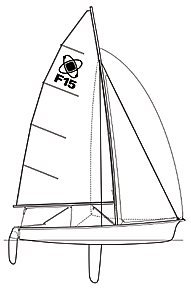Fusion 15
One Design
Here's a dinghy design from Steve Killing, the skilled Canadian designer and author of my favorite book on yacht design, Yacht Design Explained. Steve had already generated a series of dinghy sketches when he was approached by Fusion Sailboats for a dinghy that would be "fast, fun and friendly." This means that the new boat would have to fall into that wide gap between the tippy-at-the-dock rockets and the overly fat, stable sluggos that are often shoved on us as "trainers."
This is no tremendous challenge for a good designer, but it does require establishing some benchmarks and then deciding where you will apply the compromises. The first issue to be addressed in designing the hull is stability. My own Tasar was a wonderful boat to sail, but not a boat you would leave unattended at the dock for more than a few seconds. The best way to add stability in an unballasted dinghy is to change the shape of the hull in the area of the beam at waterline. If you give the boat more BWL it will be stiffer but slower. We're talking form stability here.
The shape of Steve's hull for the Fusion 15 shows a firm turn to the bilge extending aft and a moderate amount of deadrise amidships fairing to a flat at the transom. Dockside stability will be excellent without compromising planing potential. I'm not confident offering more insight into this boat's performance without the opportunity to sail it alongside the 15-foot Tasar, with which I am much more familiar. The centerboard is deep and housed in a trunk that only protrudes six inches above the cockpit sole, making it an ideal foot rest.
I don't much care for the shape of the bow, but there is a reason for this almost clipperlike profile. After wrestling with whether to have a spinnaker or not, Killing and Fusion decided to forego the complications of a normal chute and go with an asymmetrical. In order to avoid the bother and expense of an extending bowsprit Steve extended the bow profile enough to pull the tack point of the asymmetrical eight inches forward of the jib. This helps you jibe the chute around the jib stay.
Another interesting aspect of this rig is the slick self-tacking jib. There is a single jib sheet that leads up the mast from the self-tacking jib track and then down to a swivel jam cleat just below the boom vang on the mast. You can play with the jib sheet as you tack or you can ignore it. This is essentially the same jib sheet arrangement that I use on my Saga series boats and that you see on the big fancy Wally yachts.
The rolled deck edge works well ergonomically, and the open transom is ideal for a dinghy and will empty the cockpit of water in seconds. Bailers are a drag-both kinds. The open transom forces the builder to use a rudder hump to mount the rudder. Think I'll call it a "rump." This cockpit is extremely clean. The hiking straps are mounted on the centerboard trunk, which puts them at the perfect angle for comfy crew hiking.
I know you can have fun in slow boats. But if you start with a boat that has a reasonable performance potential I firmly believe you and your kids will learn faster. If you enjoy the X-games approach to sailing you can buy a 49er. If you want to sail in a more relaxed style maybe the Fusion 15 is the boat for you. I know this boat is just the type I would enjoy-stable enough to move around in easily and fast enough to scream off on a planing reach when the wind gets over 15 knots.

Comments